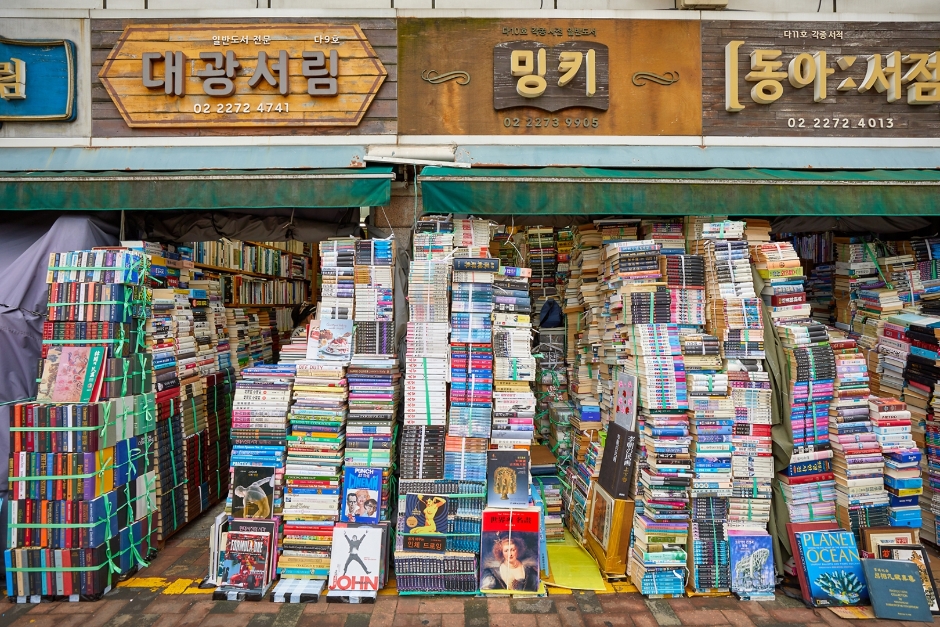Jigott - Hyundai Dongdaemun Branch [Tax Refund Shop] (지고트 현대동대문)
2.1Km 2024-04-22
20, Jangchungdan-ro 13-gil, Jung-gu, Seoul
-
Look Optical - Hyundai Dongdaemun Branch [Tax Refund Shop] (룩옵티컬 현대동대문)
2.1Km 2024-04-18
B1, 20, Jangchungdan-ro 13-gil, Jung-gu, Seoul
-
Fila - Hyundai Dongdaemun Branch [Tax Refund Shop] (휠라 현대동대문)
2.1Km 2024-04-23
7F, 20, Jangchungdan-ro 13-gil, Jung-gu, Seoul
-
Cheonggyecheon Old Books Street (청계천헌책방거리)
2.1Km 2023-12-22
20 Jangchungdan-ro 13-gil, Jung-gu, Seoul
Walking east along Cheonggyecheon Stream, which flows near Sewoon Plaza, you will see a cluster of small bookstores. Books published 30 to 50 years ago, and various out-of-date magazines are piled up in about ten bookstores. You can indirectly experience the old culture and history that formed the basis of K-content, and sometimes you can also find foreign books. Nearby is Dongdaemun Market, a wholesale market selling various subsidiary materials, and Pyounghwa Market (open from night to early morning), where you can browse clothing fabrics, which are excellent places to visit together.
Park Hong Geun Home [Tax Refund Shop] (박홍근홈패션)
2.1Km 2024-06-27
20, Jangchungdan-ro 13-gil, Jung-gu, Seoul
-
Daily Like [Tax Refund Shop] (데일리라이크)
2.1Km 2024-06-27
2F, 20, Jangchungdan-ro 13-gil, Jung-gu, Seoul
-
Laura Ashley [Tax Refund Shop] (로라애슐리)
2.1Km 2024-06-27
20, Jangchungdan-ro 13-gil, Jung-gu, Seoul
-
Slou Bed [Tax Refund Shop] (슬로우베드)
2.1Km 2024-06-27
2F, 20, Jangchungdan-ro 13-gil, Jung-gu, Seoul
-
![Jigott - Hyundai Dongdaemun Branch [Tax Refund Shop] (지고트 현대동대문)](http://tong.visitkorea.or.kr/cms/resource/22/2889122_image2_1.jpg)
![Look Optical - Hyundai Dongdaemun Branch [Tax Refund Shop] (룩옵티컬 현대동대문)](http://tong.visitkorea.or.kr/cms/resource/26/2889126_image2_1.jpg)
![Fila - Hyundai Dongdaemun Branch [Tax Refund Shop] (휠라 현대동대문)](http://tong.visitkorea.or.kr/cms/resource/91/2889091_image2_1.jpg)

![Park Hong Geun Home [Tax Refund Shop] (박홍근홈패션)](http://tong.visitkorea.or.kr/cms/resource/84/3314384_image2_1.jpg)
![Daily Like [Tax Refund Shop] (데일리라이크)](http://tong.visitkorea.or.kr/cms/resource/21/3313321_image2_1.jpg)
![Laura Ashley [Tax Refund Shop] (로라애슐리)](http://tong.visitkorea.or.kr/cms/resource/41/3313841_image2_1.jpg)
![Sealy [Tax Refund Shop] (씰리침대)](http://tong.visitkorea.or.kr/cms/resource/25/3314325_image2_1.jpg)
![Tempur [Tax Refund Shop] (템퍼)](http://tong.visitkorea.or.kr/cms/resource/15/3314515_image2_1.jpg)
![Slou Bed [Tax Refund Shop] (슬로우베드)](http://tong.visitkorea.or.kr/cms/resource/30/3314330_image2_1.jpg)
 English
English
 한국어
한국어 日本語
日本語 中文(简体)
中文(简体) Deutsch
Deutsch Français
Français Español
Español Русский
Русский